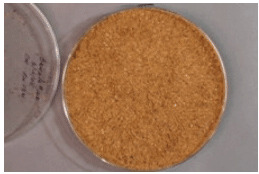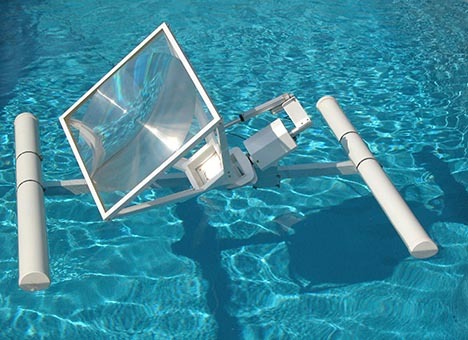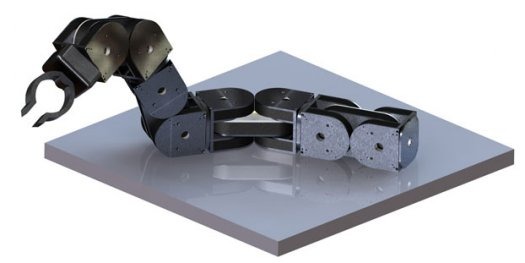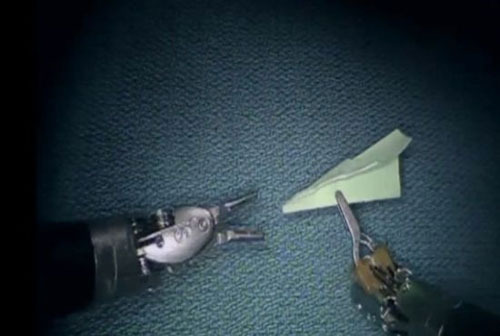SlashGear Science Week In Review
This week in science: a very different kind of "mystery meat", the climate dangers of contrails, and and artificial leaf that does more than make your office look nicer. And robots: a robot that puts the "personal" in PC, a robot that can build other robots, and a robot that makes paper airplanes (but is not a slacker). Also, fighting fire with electricity, a floating solar power plant and T-Rex's new cousin. Stay tuned!
Plastic Made From Mystery Meat
Since Mad Cow disease made it clear that using old meat and bone meal (MBM) as animal feed was a really really bad idea, millions of pounds of the stuff are ending up in landfills. Scientists, presenting research at a meeting of the American Chemical Society, have proposed a new use for the nasty stuff.

The ground up animal slurry can be used to make partially biodegradable plastic, which uses less petroleum. Then, when the material is mixed with ultra-high-molecular weight polyethylene (UHMWPE), it creates a very durable material with the bonus of being partly biodegradable. And any of the infectious agents in the material would be removed during manufacture.
Okay, but don't ask me to eat off of it.
[via American Chemical Society]
Clouds, Contrails and Climate
The air travel industry has been under fire for the carbon emissions generated by planes and their possible impact on the climate, but carbon emissions might not actually be the biggest climate problem associated with air travel. According to a study in the journal Nature Climate Change, the clouds, or contrails generated by planes may have the biggest impact.

Over time, the clouds produced through contrail water vapor evolve into "contrail cirrus" clouds, losing their linear features and looking more like naturally occurring cirrus clouds. The problem is that though low-altitude clouds cool the planet by reflecting sunlight, high altitude clouds such as cirrus are insulating and cause more warming. Though these aircraft-generated clouds suppress the formation of natural cirrus clouds, partially offsetting the impact they make, they are still the largest contribution to climate related to aircraft.
One upside is that if we can find a way to change the cloud formation caused by aircraft, the impact would be seen immediately.
[via Wired]
Artificial Leaf Could Provide Cheap Power to the Developing World
Scientists at the 241st Meeting of the American Chemical Society released details on a new design, an advanced solar cell married with fuel cells. Instead of transforming sunlight into stored sugars for a plant's metabolism, the artificial leaf uses the energy to transform water into hydrogen and oxygen for later combustion.

Daniel Nocera, the MIT chemist responsible for this amazing piece of technology, said: "Nature is powered by photosynthesis, and I think that the future world will be powered by photosynthesis as well in the form of this artificial leaf."
Researchers claim that this device could power a home in the developing world. Wired UK reports that the scientist has negotiated with Tata Group of India to produce a power plant smaller than a car. Should we think of that like an artificial tree? Nocera said, "One can envision villages in India and Africa not long from now purchasing an affordable basic power system based on this technology." The deal is slated to wrap up late 2012.
The fuel cell technology sounds a bit similar to the Bloom Energy Server we wrote about recently.
A commenter on our story expressed skepticism that big power companies would ever let something like this come to light. Here's hoping he's wrong about that, and that the spread of information and easy access to it will make it harder for things like this to be squashed.
[via Kevin Fubar, SlashGear]
Fighting Fires - No Water Needed
In more news from the recent meeting of the American Chemical Society (ACS), a new application of an old technology could aid in fighting fires – sans water. The device is a backpack with a wand attached, which shoots a beam of electricity into flames. The electricity can snuff out the fire, or at least make fighting it easier. Ludovico Cademartiri, Ph.D., and his colleagues in the group of George M. Whitesides, Ph.D., at Harvard University, "described a discovery that could underpin a new genre of fire-fighting devices, including sprinkler systems that suppress fires not with water, but with zaps of electric current, without soaking and irreparably damaging the contents of a home, business, or other structure."

The concept of using electricity to control flames is around 200 years old, but there has not been much research done to develop the technology. But now, researchers have connected a 600 watt amplifier to a wand, and used it to beam electricity into flames reaching one foot or higher. In the tests, the flames were quickly snuffed out over and over again, using only electricity. It appears that carbon particles, or soot, is the key to this phenomenon. Soot particles can become easily charged, and respond to the electric field, making the flames unstable. "Combustion is first and foremost a chemical reaction – arguably one of the most important – but it's been somewhat neglected by most of the chemical community," said Cademartiri. "We're trying to get a more complete picture of this very complex interaction."
This could potentially be used remotely, when firefighters cannot easily get to the flames, and the researchers note it is best used in tight spaces. And best used with caution, since 600 watts could do quite as much damage to a person as it would to the flames.
[via TreeHugger]
Offshore Solar Power Plants
In more environmental news, Australian solar power company Sunengy is partnering with India's Tata Power to build a floating solar power plant off the shore of India. Sunengy, whose mission is "To bring viable and affordable solar power to the world," produces Liquid Solar Arrays or LSAs. The LSA uses traditional Concentrated Photovoltaic (CPV) technology, consisting of a lens and a small area of solar cells that tracks the sun throughout the day.

Since the LSA floats, it doesn't need expensive supporting structures. The lenses submerge in bad weather, and being on the water has the additional benefit of cooling the solar cells, increasing their life-span and efficiency. Construction of the pilot plant in India will begin in August, and Sunergy plans to go into full production sometime after 2012.
[via TreeHugger]
T-Rex's new cousin, or at least, his cousin's jawbone
Palaeontologists have identified a giant predatory dinosaur, similar in size and stature to the Tyrannosaurus Rex. The dinosaur is named Zhuchengtyrannus (meaning "Tyrant from Zhucheng") magnus, and was probably about 4 meters (13 feet) tall, 11 meters (36 feet) long, and weighed 6000 kg, or 6 1/2 tons. The palaeontologists have only found some skull and jaw bones, so the actual size is estimated. However, the bones are only a few centimeters smaller than the largest T. rex specimen. The bones were found in the city of Zhucheng, in the Shandong province of eastern China.

The dinosaur ran on strong back legs, with puny front limbs, just like the T. rex. The Zhuchengtyrannus is different from other tyrannosaurines because of some unique features in the skull. Scientists found a piece of lower jaw containing seven partly to fully erupted teeth, and another piece of jaw bone containing eight teeth. The bones were found in a quarry which contains one of the largest concentrations of dinosaur bones in the world.
Read the full paper here.
[via BBC]
iMobot Intelligent, Reconfigurable Modular Robots
The iMobot robots are small modules that link together like a chain to form larger robotic modules. The modules have two joints at the center which can rotate 180 degrees. The robots have four degrees of freedom, so they can stand themselves up, roll end over end, stack themselves, and inch along like a caterpillar. And, they are going to be available commercially soon. See them in action:
And read the full story here.
[via SlashGear]
Robotic surgical instruments make tiny paper airplanes
From Shane McGlaun, SlashGear:
I guess considering that these little robot tools can be used to fix hearts and other critical parts of the human body I shouldn't be surprised that the things can fold tiny little paper airplanes, but I am. I had no idea these tools had so much dexterity.
This isn't what bored docs get up to just to stay warm in surgical suites; this is how Dr. James Porter shows off how precise his fancy da Vinci robot really is. I am impressed Dr. Porter, but can it make an origami swan?
[via SlashGear]
Reeti puts the "personal" in personal computer
If you've ever wished that your computer was more personable, and could maybe even have a conversation with you, Reeti might be just what you're looking for.
From Chris Davies:
The desktop companion is both a PC, a webcam and a telepresence 'bot, capable of streaming live video from his webcam eyes, responding to touch thanks to various embedded sensors, and making facial expressions.
Inside is a 1.8GHz dual-core Atom CPU paired with NVIDIA Ion 2 graphics, a 500GB hard-drive, WiFi b/g/n, ethernet, three USB 3.0 ports, HDMI, digital audio outputs, Blu-ray, and more, running Ubuntu with some custom robotics tools preloaded. Hooked up to a display, keyboard and mouse, and you can use REETI as your regular desktop.
Your normal PC probably doesn't have cheeks that light up in various colors depending on mood, a head that can turn and track people in 3D (or be remotely controlled by an iPad app), or respond and track sound and key commands. REETI is also capable of reading out RSS, Facebook, Twitter and other sources, or acting as a robotic receptionist to welcome people to your business.
See the cute little guy in action:
[via SlashGear]




